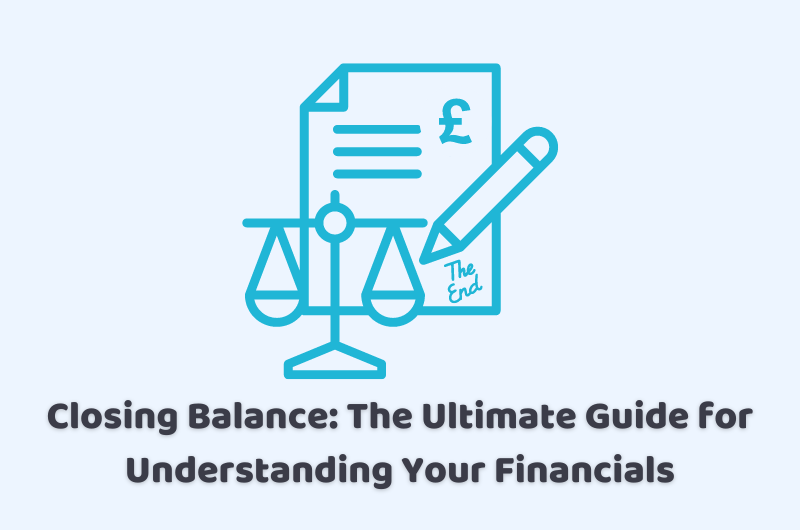
12/07/2023Accounting , Accounting Issues
The closing balance is a key financial metric that shows the money that is in an account after all transactions have been recorded. It is often used to reconcile accounts and ensure that all transactions have been recorded accurately. The closing balance can be calculated for any type of account, including bank accounts, sales accounts, and expense accounts. Further in the discussion of this comprehensive guide, we will focus on the basics of what is closing balance in banking and accounting, how to calculate the closing balance, and why is it important.
Reach out to our smart and clever-minded guys to get an understanding of the closing balance. We will help to understand your queries instantly.
What is Closing Balance in Accounting?
In accounting, the closing balance is the balance of an account at the end of an accounting period, such as a month or a year. It’s the final amount of money in an account after all transactions have been recorded for the period. The closing balance is important because it’s used to calculate the opening balance for the next accounting period. It’s also used to prepare financial statements, such as the balance sheet and income statement.
The closing balance can be positive, negative, or zero, depending on the account and the transactions that have been recorded. The closing balance is calculated by adding up all the debits and credits that have been recorded in the account and then subtracting the total debits from the total credits. If the total debits are greater than the total credits, the closing balance will be negative. If the total credits are greater than the total debits, the closing balance will be positive. If the total debits and credits are equal, the closing balance will be zero.
What is the Closing Balance in Banking?
The closing balance is the amount of money that remains in your account at the end of a business day after all transactions have been processed. It includes the starting balance, any deposits made during the day, and any withdrawals or transfers made during the day.
The closing balance is important because it determines the amount of money you have available for future transactions. It’s also used to calculate interest earned or charged on your account. You can check your closing balance by logging into your online banking or by checking your bank statement. If you have any questions about your closing balance or your account, you can contact your bank for assistance.
How to Calculate the Closing Balance?
The process for calculating the closing balance in the UK is the same as in any other country. To calculate the closing balance of an account, you need to add up all the debits and credits that have been recorded in the account and then subtract the total debits from the total credits.
The resulting amount will be the closing balance. You would follow the same process as in any other country. Here’s a more detailed example. Let’s say that a business has a sales account with the following transactions for the month of June:
- Starting balance: £5,000
- Sale on June 5: £1,000
- Sale on June 10: £1,500
- Refund on June 15: £200
- Sale on June 20: £2,000
- Sale on June 25: £1,500
To calculate the closing balance for June, you would add up all the debits and credits:
- Starting balance: £5,000
- Sale on June 5: £1,000
- Sale on June 10: £1,500
- Refund on June 15: £200
- Sale on June 20: £2,000
- Sale on June 25: £1,500
- Total credits: £7,000
- Total debits: £200
Then you would subtract the total debits from the total credits:
- Total credits: £7,000
- Total debits: £200
- Closing balance: £6,800
So the closing balance for June would be £6,800. This process can be applied to any account, whether it’s a bank account, sales account, or any other type of account.
Why is Closing Balance Important?
The closing balance is important because it represents the amount of money that is left in an account at the end of a certain period of time. This information can be used to help manage finances and make decisions about future spending.
For example, if the closing balance is low, it may be a sign that the account holder needs to reduce their spending or increase their income. On the other hand, if the closing balance is high, it may be an opportunity to invest or save the extra funds. The closing balance can also be used to reconcile accounts and ensure that all transactions have been recorded accurately.
The Bottom Line
In addition to being used for reconciliation purposes, the closing balance can also be used to help manage finances. For example, by tracking the closing balance over time, an account holder can get a sense of their overall financial health and whether they need to adjust their spending or saving habits. The closing balance can also be used to make decisions about future spending. For example, if the closing balance is low, it may be a sign that the account holder needs to reduce their spending or increase their income.
Overall, the closing balance is an important metric that provides valuable information about an account’s financial status. By understanding how to calculate and interpret the closing balance, account holders can make informed decisions about their finances and ensure that their accounts are being managed effectively.
Our team of professional members loves to hear out your business problems and find out the possible and suitable solutions quickly to the reporting in the UK. Contact us now.
Disclaimer: The information about the closing balance provided in this blog includes text and graphics of general nature. It does not intend to disregard any of the professional advice.
